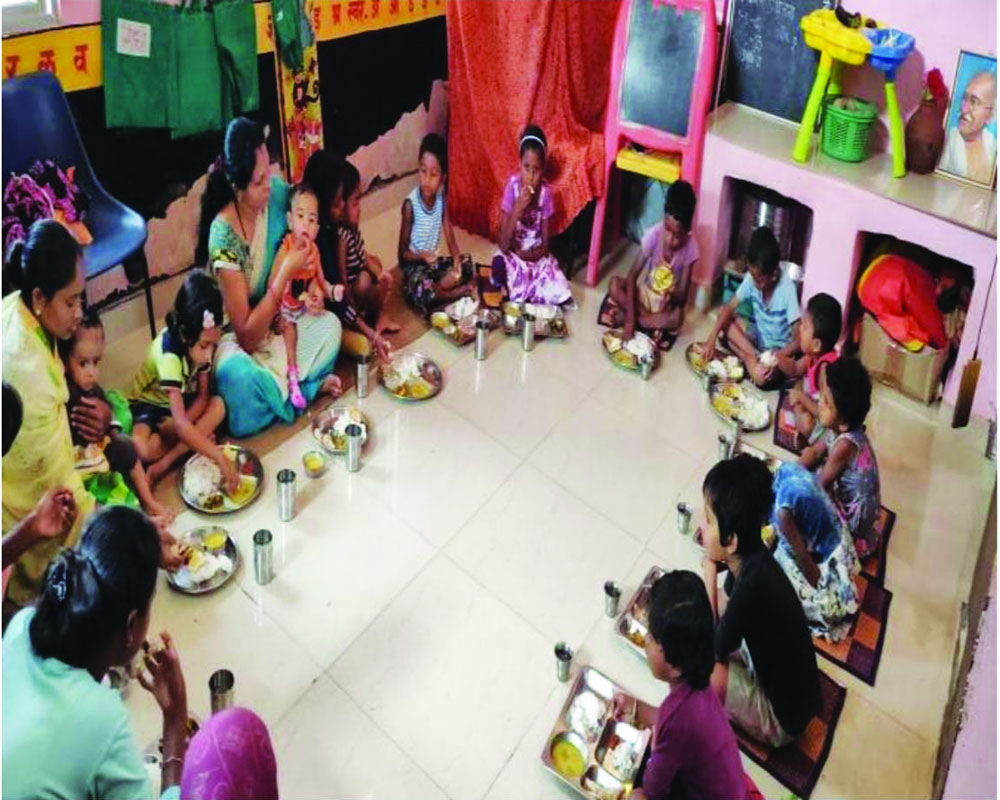The Mukhyamantri Suposhan Yojana, which was launched to curb malnutrition and anaemia, has been a huge success in Bijapur district. There has been a drastic 10 per cent fall in cases
One out of every three children in India is malnourished, making us one of the leading nations in terms of malnourished children. According to the 2018 Global Hunger Index, India ranked 103 out of the 119 qualifying countries, with a score of 31.1, which is high enough to ring the bells for serious concern for hunger deprivation. The nation houses 46.6 million stunted children, one-third globally, as per the Global Nutrition Report 2018. Approximately half of all the under-five child mortality in India is credited to undernutrition.
The crisis of malnutrition is alarming and needs immediate attention. Any leading nation can’t accomplish the economic and social development goals of the society, without addressing the basic issue of malnutrition and laying an emphasis over making its populace mentally, physically and emotionally healthy.
Chhattisgarh steps up in its battle against malnutrition
For a heavily forested and tribal-dominated state of Chhattisgarh, the issue of malnutrition came as a challenge in front of the newly formed state government led by the Chief Minister Bhupesh Baghel. Under his leadership, the Chief Minister’s Suposhan Abhiyan was launched on October 2, 2019 in the state to eradicate malnutrition from its roots.
Decrease in malnourished children in the state
According to the data received from the weight festival in the scheme launching last year, about 4,92,000 children were malnourished in the state, out of which more than 67,000 children have become free from it. Thus, there has been a 13.79 per cent decrease in malnourished children, which is a major achievement in the state’s war against malnutrition.
Bijapur Suposhan Mission
Malnutrition has been an enigma in the Bijapur district of the state since time immemorial with the dominant presence of anemia among women of the region. Scientists claim that the initial 1,000 days of an individual’s lifespan, from the day of conception till s/he turns two, is crucial for physical and cognitive development. But a majority of children, adolescent girls, pregnant women and infant mothers of the district are anemic with decreasing nutritional levels. Thereby, a malnourished mother is more likely to give birth to malnourished children, forming a vicious cycle with the birth of underweight children and the pattern continuing for ages thereafter.
Concerning the figures of the Weight festival 2019, a total of 3,632 children have been categorised as seriously malnourished and 7,100 children fall under the category of moderately malnourished in the district. Bijapur stands at a malnutrition percentage of 38.50 per cent, which is both disturbing yet challenging. The district has a population of 2,55,230 citizens, out of which 49.6 per cent i.e (1,26,594) are women, according to the 2011 census.
As per the National Family and Health Survey (NFHS) 2015-16, there are 86,970 anemic women aged between 15 and 49 years, constituting for 68.7 per cent of anemic women in the district, out of which, the percentile of anemic pregnant women stands at 47.9 per cent. 51.3 per cent of infants from the age group of six months to 59 months are anemic. The alarming figures of malnutrition, maternal mortality rate, infant mortality rate and anemia, reckoned the district administration to come up with this mission to combat malnutrition.
Benefits under the mission
Under this campaign, supplementary nutritious food in the form of eggs, ladoos, chickpea, jaggery and nutritious biscuits are provided to the identified children, women, lactating mothers, school dropouts and anemic women aged between 15 to 49 years. All the children and school dropout girls are provided with warm nutritious food. With this, 27883 children, 4663 lactating mothers, 10811 anemic women aged between 15 to 49 years, 2751 school dropout girls, with a whopping total of 46,108 people of the district have been benefitted.
Establishment of Nutrition Rehabilitation Centres in Bijapur
Nutrition Rehabilitation Centres (NRC) are being established in the district hospital and four development blocks, with the collaboration of Health Department under the scheme, for the speedy recovery and health improvement of severely malnourished children. Additionally, with the aid of one district hospital, five community centres and 10 primary health centres, health check-ups are conducted regularly for pregnant and lactating mothers and malnourished children of the district.
Reduction in malnutrition levels within 13 months in the district
The mission started bearing fruitful results within 13 months with the revival of 2,779 severely/ moderately malnourished children, getting free from the cycles of undernourishment. Due to the constant efforts and the objective set out by the CM to eradicate malnutrition from its roots, a drastic 10 per cent reduction has been witnessed in the levels of malnourishment in the district.
The malnourishment rate has come down from 38.50 per cent to 28.52 per cent with the number of malnourished children decreasing from 10,732 to 7,953. The anganwadi workers of the district are provided with regular training for the successful implementation of the scheme. Additionally, kitchen gardens are being established in all the anganwadi centres with 276 (fixed wire fencing) and 819 kitchen gardens being established in the workers and assistants premises. Papaya and drumsticks are being planted in the gardens of the beneficiaries to encourage them to avail proper nutrition. Awareness is created through social participation of the Self Help Groups in the gram panchayats of the villages, where information is disseminated regarding proper nutrition and health.
Distribution of dry ration material amid lockdown
Amid the closure of all the anganwadi and mini anganwadi centres for the prevention and control of COVID-19 in the state, distribution of dry ration material such as wheat flour, rice, pulses, gram, potatoes and soybeans had been ensured. Additionally, children were also weighed regularly by anganwadi workers by visiting their homes.
Bijapur is one fine example of the successful implementation of the Mukhyamantri Suposhan Abhiyan in the state. The World Bank has also appreciated the control and prevention of COVID in the state and the distribution of take away ration conducted by anganwadi workers in the state.
Eradication of malnutrition is a community campaign and involves citizens participation and cooperation for the achievement of its goals. It is a time taking process but Chhattisgarh will fulfill its goals in terms of providing people with nourishment and proper nutrition.


























